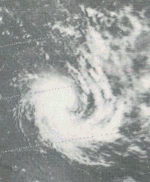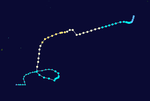Cyclone Wanda
| 1973–74 Australian region cyclone season | |
|---|---|

Season summary map
|
|
| Seasonal boundaries | |
| First system formed | 17 November 1973 |
| Last system dissipated | 23 March 1974 |
| Strongest storm | |
| Name | Jessie |
| • Maximum winds | 165 km/h (105 mph) (10-minute sustained) |
| • Lowest pressure | 964 hPa (mbar) |
| Seasonal statistics | |
| Tropical lows | 19 |
| Tropical cyclones | 19 |
| Severe tropical cyclones | 9 |
| Total fatalities | Unknown |
| Total damage | Unknown |
| Related articles | |
| Category 3 severe tropical cyclone (Australian scale) | |
| Category 1 tropical cyclone (SSHWS) | |
| Duration | November 17 – November 24 |
|---|---|
| Peak intensity | 130 km/h (80 mph) (10-min) 970 hPa (mbar) |
| Category 2 tropical cyclone (Australian scale) | |
| Tropical storm (SSHWS) | |
| Duration | November 21 – December 8 |
|---|---|
| Peak intensity | 110 km/h (70 mph) (10-min) 981 hPa (mbar) |
| Category 3 severe tropical cyclone (Australian scale) | |
| Category 1 tropical cyclone (SSHWS) | |
| Duration | November 26 – December 4 |
|---|---|
| Peak intensity | 125 km/h (75 mph) (10-min) 973 hPa (mbar) |
| Category 1 tropical cyclone (Australian scale) | |
| Tropical storm (SSHWS) | |
| Duration | December 1 – December 2 |
|---|---|
| Peak intensity | 65 km/h (40 mph) (10-min) 995 hPa (mbar) |
| Category 3 severe tropical cyclone (Australian scale) | |
| Category 1 tropical cyclone (SSHWS) | |
| Duration | December 11 – December 19 |
|---|---|
| Peak intensity | 125 km/h (75 mph) (10-min) 973 hPa (mbar) |
| Category 1 tropical cyclone (Australian scale) | |
| Tropical storm (SSHWS) | |
| Duration | December 15 – December 20 |
|---|---|
| Peak intensity | 85 km/h (50 mph) (10-min) 988 hPa (mbar) |
| Category 3 severe tropical cyclone (Australian scale) | |
| Category 1 tropical cyclone (SSHWS) | |
| Duration | December 20 – December 25 (Crossed 80°E) |
|---|---|
| Peak intensity | 150 km/h (90 mph) (10-min) 964 hPa (mbar) |
| Category 2 tropical cyclone (Australian scale) | |
| Category 1 tropical cyclone (SSHWS) | |
| Duration | December 29 – January 5 |
|---|---|
| Peak intensity | 110 km/h (70 mph) (10-min) 977 hPa (mbar) |
| Category 2 tropical cyclone (Australian scale) | |
| Tropical storm (SSHWS) | |
| Duration | January 6 – January 13 |
|---|---|
| Peak intensity | 95 km/h (60 mph) (10-min) 982 hPa (mbar) |
The 1973–74 Australian region cyclone season was a very active tropical cyclone season.
On November 17, Ines formed offshore the Top End. Moving westward, the cyclone passed north of Bathurst and Melville islands. Thereafter, Ines curved southwestward and intensified into a 130 km/h (80 mph) cyclone while nearing Troughton Island. The storm made landfall in Kimberley, Western Australia on November 19. Ines slowly weakened after moving inland and dissipated on November 24.
Cyclone Annie developed northwest of Western Australia on November 21. By December 8, it dissipated.
Beryl formed just south of the Lesser Sunda Islands on November 26. The cyclone strengthened, peaking with winds of 125 km/h (75 mph) on December 1. Three days later, Beryl made landfall near Carnarvon, Western Australia and quickly dissipated. Minor wind damage was reported.
Cyclone Lottie struck Fiji's Southern Lau Group on December 10. High seas caused the ship Uluilakeba to capsize killing more than 85 people.
The next system, Cecily, developed near the Cocos Islands on December 11. Cecily moved south-southwestward and peaked with winds of 125 km/h (75 mph). On December 19, the cyclone dissipated.
Una formed southwest of Solomon Islands on December 15. It struck Queensland before dissipating on December 20.
Cyclone Deidre developed in the vicinity of the Cocos Islands on December 20. Moving generally west-southwestward across the Indian Ocean, it crossed the 80°E on December 25.
Tropical Cyclone Erica brought heavy rainfall to portions of Western Australia.
Fiona-Gwenda was operationally considered two different tropical cyclones.
On January 18, Cyclone Vera developed offshore Queensland. After moving northeastward, it then curved to the southeast. On January 20, Vera crossed 160°E and entered the South Pacific basin.
...
Wikipedia














